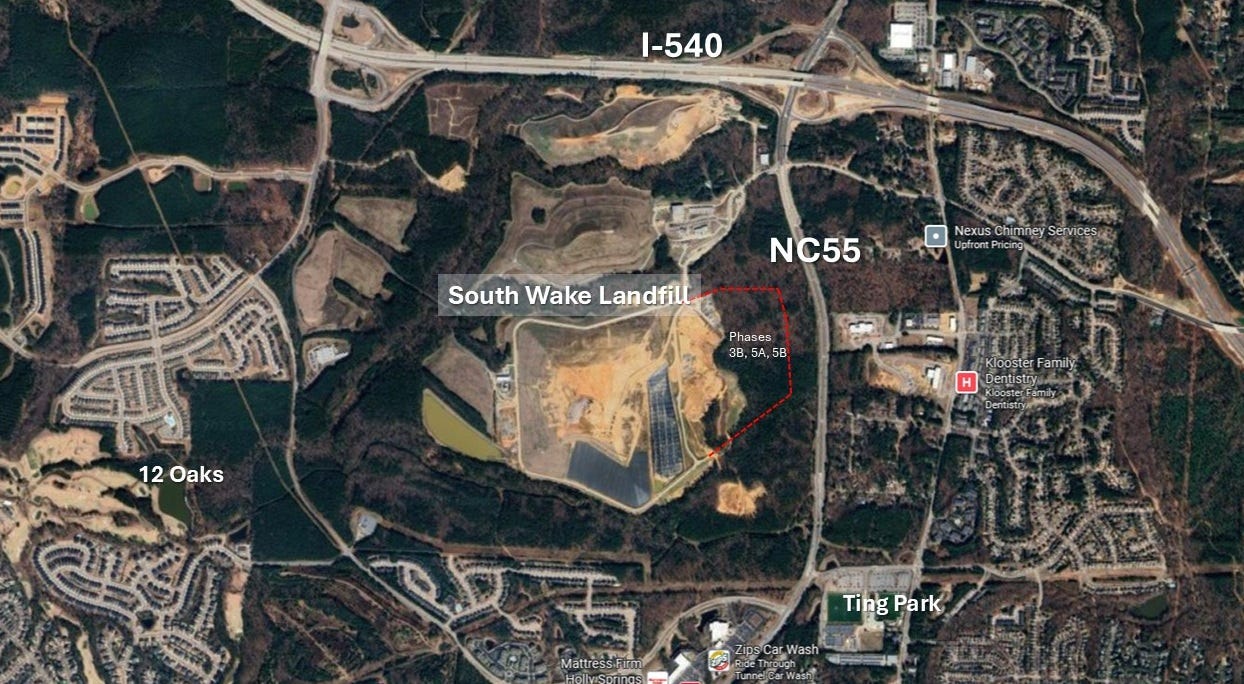Beyond the South Wake Landfill: Wake County Weighs Future as Odor Complaints Continue
County begins planning for life after the South Wake Landfill, tackling odors, health concerns, and tough choices about where the county’s trash will go when the site reaches capacity.
Holly Springs, NC, Sep. 9, 2025 — Wake County officials are facing growing questions about the South Wake Landfill’s future, as odor complaints surge and residents continue to voice concerns about environmental and health impacts. During the County Commissioners’ work session on Monday, September 8th, Solid Waste Director John Roberson and consultant John Boyer discussed and reviewed with the commissioners the long-term challenges of keeping the county’s trash system running once the South Wake facility reaches capacity.
The session marked a critical turning point in what many see as the county’s most pressing solid waste issue: what happens next when the landfill is full? Officials acknowledged that the South Wake Landfill, which takes in roughly 1,700 tons of garbage every day from more than 400,000 households, is projected to close between 2040 and 2045. With the design, permitting, and construction of new disposal facilities often taking more than a decade, commissioners are now weighing options for the county’s next trash disposal solution.
The Beyond the South Wake Landfill Study (document) presentation shared during the meeting serves as the blueprint for answering those questions, while also engaging residents, municipalities, businesses, and regional partners in shaping how Wake County will manage its trash for decades to come.
Holly Springs’ Long History of Landfills
For many residents, the conversation is about more than one facility. As chronicled in Holly Springs Update’s four-part series Dumping on Holly Springs, the community has hosted a succession of landfills dating back to the 1950s. Those included the Elwood Pines Dump, the Holly Springs Dump, and the Cary Sanitary Landfill, sites that later became residential areas despite contamination concerns. Wake County purchased the current South Wake property in 1974, and after years of debate and lawsuits, opened the facility in 2008.
The landfill has since become the centerpiece of the county’s waste disposal system. Its eventual closure means Wake County must determine not just what to do with the site itself, but also how to keep up with the daily disposal needs of a fast-growing population.
Odors Drive Resident Frustration
While odors have long been a flashpoint, county staff acknowledged in the work session document that the past few months have seen a “surprising increase” in reports. The Division of Solid Waste and Recycling attributed the rise to four factors:
Heavy rainfall that temporarily knocks down odors but leaves waste “soured,” making daily cover less effective.
Opening of Phase 2C, which places waste at the same elevation as nearby homes, making control harder.
Leachate treatment plant effluent from a reverse osmosis system installed in 2023–24, which carries a sewer-like odor.
Landfill gas system expansion delays, with work pushed into the late summer, a period typically associated with odor problems.
The county has deployed mobile vapor and stationary misting systems and committed $13 million over the next decade to address odors, including $3.7 million this year. Still, many residents say the smell is a daily reminder that Holly Springs shoulders Wake County’s trash burden — and that the county must think carefully about what comes next.
Environmental and Health Questions
Beyond nuisance odors, residents continue to press for assurances that the landfill is not compromising their health. Groundwater monitoring wells surround the site, and Wake County offers free testing of nearby private wells. Air monitoring focuses on methane and volatile organic compounds (VOCs), which can pose health risks. Residents have reported headaches, respiratory issues, and skin irritation, and many have called for independent health studies and real-time air alerts.
These concerns feed directly into the larger debate. As the county considers future disposal methods, residents want public health protections and transparency to be at the center of the decision-making process.
Planning for Life After the Landfill
According to the document shared, the Beyond the SWLF Study has four goals:
Evaluate disposal options, including a new county-owned landfill, hauling to regional landfills, building a waste-to-energy plant, or adopting emerging disposal technologies.
Engage stakeholders and the public, weighing economic, environmental, and social criteria.
Strengthen partnerships, both locally and regionally, as landfill capacity across the Triangle declines.
Develop an adaptive plan that accounts for growth, technology changes, market shifts, and regulatory uncertainty.
The study also considers post-closure uses for the site itself. Ideas include expanding renewable energy generation through solar panels, creating green space with trails and overlooks, or building an environmental education center. At its projected final height of 520 feet, 140 feet above the town’s average elevation, the capped landfill will loom large over neighboring communities.
Next Steps: Answering “What’s Next?”
The work session materials outline a five-phase process: evaluating disposal options, engaging the public, exploring regional partnerships, analyzing energy markets, and identifying a preferred option.
In the coming months, the county will hold stakeholder meetings with municipal partners, environmental groups, and business interests. Public engagement efforts will include social media campaigns, in-person and virtual information sessions, and surveys. The goal is to complete the engagement process by the summer of 2026.
For area residents, the discussions bring both frustration and opportunity. “Instead of a monument to waste, the closed landfill could become a community asset—whether that’s renewable energy, a park, or a place to learn about sustainability,” one resident suggested.
County leaders emphasized in the document that planning now is essential, since designing and permitting a new disposal facility can take more than a decade. That means the decisions made over the next two years will play a critical role in shaping how Wake County answers the “what’s next?” question once the South Wake Landfill reaches capacity.

